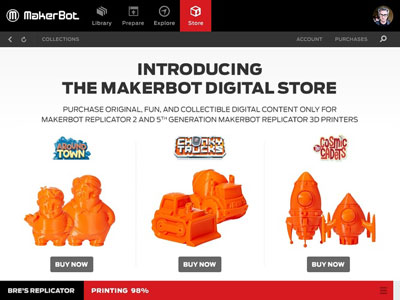| Jan 20, 2014 |
What price our fascination with cheaper 3D printing?
|
|
(Nanowerk News) The future of 3D printing is firming up as it moves from do-it-yourself tinkerers to key players selling complete consumer solutions. This shift brings important ecological and socio-economic implications.
|
|
According to Google Trends, interest in 3D printing increased tenfold in the past two years and shows no signs of slowing down for 2014.
|
|
And it wasn’t just the gimmick of 3D printed wings adorning Victoria Secret models that turned heads.
|
|
Online, all of those Google searchers were interested in printing everything from food and guns to houses and even fascinators (for the Melbourne Cup).
|
|
This year, even Martha Stewart, the American home decoration magnate, declared 3D printing a “good thing” and ordered a few printers herself.
|
|
Post offices in France are rolling out 3D printers much like UPS Store in the US. The UK grocery chain Asda is dabbling in the technology as well, offering shoppers a chance to get a mini 3D printed model of themselves.
|
|
Create ‘mini me’ models of you and your family.
|
|
3D printing is starting to add up for consumers too. A recent experiment by Michigan Technological University showed that, by cheaply making “disposable” household items that would otherwise have to be bought elsewhere (think shower rings and smartphone cases), a US$2,000 3D printer would pay for itself in less than a year.
|
|
Why the explosion of interest? As was covered here and elsewhere, many key 3D printing patents continue to expire, and this allows new firms to innovate, compete and explore new business models.
|
|
As these 3D printing business models solidify, the bright promises of a new industrial revolution are meeting distinct ecological and social realities.
|
|
3D junk
|
|
Ecologically, while 3D printing may be “greener” than traditional manufacturing, economies of abundance instead of scarcity could create new problems.
|
|
3D printing might upend consumption patterns, but if the logic of economies of abundance that exist in digital content filter through to 3D printing, we’ll be awash in plastic junk.
|
|
Preliminary studies of the full environmental life cycle of plastic products suggest that distributed manufacturing with 3D printers can lower the environmental impact of a range of goods by over 40%.
|
|
That’s because 3D printing gets rid of the complex commercial logistics chains needed for each product, and the actual printing process allows more objects to be printed from less material.
|
|
However, as 3D printing continues to lower the barriers to manufacturing, conspicuous consumption may accelerate.
|
|
Think of how ephemeral our interest in digital content is. What if, instead of each new song or podcast you listened to, you downloaded a better smartphone case or must-have figurine for the kids?
|
|
How quickly would you get bored of each object if the next thing is just a click and 3D print away? What will we do with all the abundant, accessible, and cheap self-mass-production?
|
 |
| 3D printed smartphone cases. (Flickr/Shapeways)
|
|
3D printing may lessen commercial consumption, but a homemade flood of discarded objects may still fill childrens’ toy chests and parents’ sheds.
|
|
Recycling
|
|
Recycling consumer 3D printed objects is possible, but it takes energy and only makes production and consumption more efficient – not effectively sustainable. If production increases more than efficiency, we’re still at an environmental loss.
|
|
Recycling schemes that do exist are already following all too familiar patterns of global inequality. A group of “social entrepreneurs” suggest certifying “ethical filaments” to fuel the 3D printing drive via developing nations.
|
|
In this scheme, labourers in developing nations pick through landfills in “waste picker groups” looking for plastic scraps to sell to the new market of recycled filaments firms. At least we’re not buying “conflict filament” (think conflict diamonds and conflict minerals). Although “ethical” petrochemicals are already being marketed.
|
|
3D printing monetised
|
|
Aside from the material-ethical implications of 3D printing business models, socio-economic implications are evolving too.
|
|
3D printing has so far required a “do it yourself” knack for experimenting and a free and open source knowledge base.
|
|
Now, firms are providing seamless, vertically integrated experiences attached to familiar Web 2.0 monetisation models. So, 3D printing is mirroring the corporate turn of Web 2.0 business models that offer services which monetise users' data and relationships while shifting ownership of content to the business.
|
 |
| 3D collectibles, the new thing from a digital store. (Image: MakerBot®)
|
|
For instance, onetime DIY darling 3D printing company Makerbot recently unveiled its own proprietary online store, where consumers can download exclusive snap-together toys and solid plastic figurines.
|
|
The files are similar to an iTunes music file, and come with similar Terms of Use.
|
|
Users don’t own the content; they license unlimited prints for personal, non-commercial purposes — although those terms may change at any time.
|
|
Of further concern is that the Makerbot file format that users pay for only works in Makerbot printers, and cannot be easily reverse engineered or remixed.
|
|
Note that Makerbot does continue to host a more open repository of objects, at Thingiverse.com, where paid and free (as in beer and speech) content can be found.
|
|
Another company, Pirate3D, goes even further in ease of use and intellectual restrictions. Pirate3D hopes to manufacture Apple’s business playbook in the 3D printed world.
|
|
The firm aims to provide its customers with sleek design and vertical integration that makes 3D printing cool and ensures that it “just works”.
|
|
Like Makerbot, Pirate3D will also offer two tiers of free and paid goods, but keeps its intellectual property even closer. Their main innovation is a printer that operates via their cloud.
|
|
Pirate3D’s cloud “treasure island” hosts curated objects for sale and print. It allows you to tweak their shape with a simple tablet application — no PC required to print.
|
|
Control of that digital content, including one’s ability to view, modify and print goods, resides with Pirate3D’s servers. We must hope that they don’t sink their own ship, or run afoul of copyright barons.
|
|
When Amazon has been known to delete books from Kindles, the prospect of having your favourite 3D widget “disappeared” is real.
|
|
Finally, if you still wish to print your own content and make friends doing it, the communal aspect of 3D printing is alive, well and monetised.
|
|
For a small fee, the web service 3D Hubs provides connections for “people who want to print to the people owning the machines”. Owners of machines can print jobs at their convenience.
|
|
3D printed reality
|
|
The evolving monetisation of 3D printing shows the industry is growing up: 3D printed goods are moving out of basements and into kitchens, playrooms and mainstream consumption patterns.
|
|
With that change comes market structures that mimic, for better and worse, the social and economic logics of successful web businesses. It will be interesting to see how well these models will work for consumers, industry and the environment.
|


